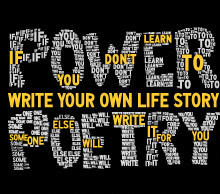
Rap and poetry are actually the same thing. Rap is short for rhythm and poetry. As a poet, you’re already familiar with some elements of rap but not all of them.
Rap is different because it’s constantly full of rhythm and rhymes. Not all poems follow an inherent rhythm, and oftentimes today, they don’t adhere to classic rhyme schemes. Rap, however, is rhyming poetry smoothed over a beat.
If you’re a poet branching out into rap, you’re also going to have to switch up your poetry. A sonnet on a page may be abundant with visual metaphors, but when writing rap, it needs to sound good. It needs to appeal to the ear with a concise message--all while keeping rhythm.
How To Write A Rap Song in 7 Steps
Ever wondered about the concrete steps to write a rap song? Here’s how.
1. Find your topic or inspiration. If you already have something you want to to write about, great! If not, it’s helpful to brain dump, or write down all the things that come to mind. Once you do this, you can pick a topic or subject that you feel most connected to. That’ll help you get going once it’s time to write lyrics.
2. Get familiar with structure. You can find rap songs using all sorts of different beat patterns and structures, but if you’re just getting started, stick to basics. Most raps have a verse, chorus, verse, chorus, bridge, then chorus. The verse is a space to tell your story and its details. Each verse tends to lead nicely into the chorus, which is often the song’s most memorable chunk. The bridge, which is optional, can be a place to switch up the melody and include your song’s revelation.
3. Sit down and write lyrics, or "bars" in rap lingo. Keeping your topic and the general structure in mind, you’re ready to write lyrics. If you feel stuck, get in the zone. You can do this by setting a timer on yourself as you write. This pressure will help you focus on your flow of words. Or, listen to some of your favorite or some new artists whose work may inspire.
4. Rewrite and refine. Once you have your lyrics down, it’s important to go back and edit keeping this in mind: rap is abundant with rhymes and melody. If your first draft isn’t catchy or full of clever rhymes, that’s okay. Now is the time to add them, and you can use tools like a rhyme dictionary.
As you edit your rap, read it out loud. As you listen to it, make edits wherever it’ll help the rap keep rhythm. As you listen to it, think about what story it’s telling, what mood it’ll put people in, and what rhymes it needs.
5. Practice out loud. Nothing you write will ever be perfect, but when you’ve got a rap you’re satisfied with, start practicing out loud. Most people who are starting out find it easier to practice alone. If that’s you, practice with no mirror first then do it in front of a mirror. You can record a video to watch your evolution over time. If you feel comfortable, practice with someone you trust who will support you while giving constructive feedback.
6. Memorize! Here’s a fun challenge. Once you’ve written your rap and practiced a few times out loud, try memorizing and recording it. This will help build your confidence around your lyrics and your voice. You can develop this “memorizing muscle” and make it easier to memorize your raps over time.
7. Yes, share it. You deserve this. You’ve put hours of work and practice into this! Sometimes sharing your rap can feel like the hardest part of the process, but you should push yourself to share your art with the world (or a very small slice of it). This can be a fun way to tell people what you’ve been up to, build a community, or gain a following.
It’s time! Now that you know how to write a rap song, get writing. Maybe you’re the next Jay-Z or Nicki Minaj? The next 6LACK or Doja Cat? Or just the next and only you? Share your work here on PowerPoetry.org or check out an online rap battle.
